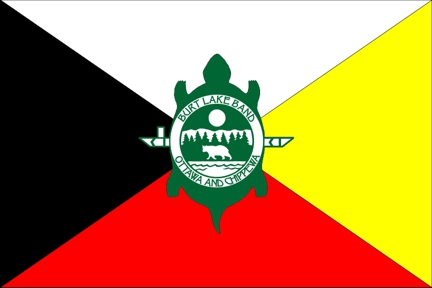This article was originally published by Interlochen Public Radio on October 1, 2024.
A new book from the Burt Lake Band of Ottawa and Chippewa Indians is an introduction to foraging wild foods with contemporary recipes to boot. But those behind it say it’s more than just a cookbook.
No matter where you look, in the garden or in the woods nearby, there is something to be harvested.
And that’s the point behind “Naajimiijimedaa!… (Let’s Find Food!)” a three year project — and also the title of the resulting book.
Rebuilding connections
Over 100 years ago, a group of white men stole 300 acres that belonged to the tribe and burned the village to the ground.
Author and grant writer Kathy Kae, and others, wanted to create something to reconnect people to that land.
“Because they were landless for a long time … a lot of people had to disperse,” Kae said. “And because of that, (people) lost a lot of the connections to all the food sources on that land.”
With help from a grant, they came up with a project about harvesting. It included workshops and, ultimately, this book.
“It really provides a connection, not just with the band, families or community, but a connection back with that land and the creator and everything how it was meant to be,” Kae said. “You know, it really provides a sense of pride to be harvesting.”
The tribe invited citizens and people with experience harvesting wild foods to participate in the first two years of the project. Citizens from all generations showed up to harvest together on the land. Barb Richmond, a tribal elder, was among them.
“Like, when we went ricing, we had, I don’t remember how many canoes,” Richmond said. “There was one young couple with us, and everybody else was fine, but they tipped their canoe, and so right away, that made for a lot of laughs.”
“They weren’t having fun, but we thought it was funny,” Kae said.
Harvesting wild foods brought back fond memories for Richmond. She grew up downstate but would come up north to see her big family. Her mother was one of nine kids, so there were lots of cousins around.
“There was always someone there, and they were always fishing, and then, you know, cleaning the fish, and the kids were always around to see this or try to help,” Richmond said. “It was just always fun being there. Everything we did seemed like fun. So it’s nice to see this again.”
Tribal treasurer and elder Ken Parkey also shared stories that are featured in the book.
Parkey talks about using pine pitch to treat wounds. Once, he had cut a gash in his foot with axe.
“My mom was out in the garden, and when I knew I cut it, boy I took off for the garden. Hollered at her, and she said, ‘Get in the house!'” Parkey said. “She followed me in there and got a pan of water and washed that thing out. … She went and got the pine and slapped that on there and wrapped my foot up. (It) hurt like everything.”

Kae used that story in the book. After she added it, she used pine pitch to treat a cut on her toe and said that it worked. Another story in the book from Barb Richmond talks about using tree sap to make a nutritional beverage.
“When they tap a tree, you know, it comes out like sugar water,” Richmond said. “If you drink that, it’s got a lot of nutritional value. In fact, my grandma used to have a sugar shack. They made syrup, she always had a pan of that. We called it ‘dirty water.'”
Those kinds of stories and memories from tribal members are also featured in the book.
While the tribe was bringing citizens out to forage, author Kathy Kae was also interviewing elders about their memories of gathering food, from grandparents to parents, to their own children.
Each registered citizen of the Burt Lake Band no matter the age will get a copy of the book.
“One good thing about every tribal member getting it is that it’s preserving some of their history, especially with the memories of stories and stuff like that,” Kae said.
Barb Richmond said it’s much more than a cookbook.
“So happy we got to do that,” Richmond said. “It’s more than just a recipe book. I think anybody would enjoy this cookbook. You don’t have to be native. Anybody would.”
Anyone can purchase it through the Burt Lake Band’s website. Proceeds from the sales will go to a community building fund. But the overall idea is about more than that.

Being out harvesting together reminded Richmond that today’s fast world needs to slow down and that we should appreciate what’s right in front of us.
“When I look out here, all this stuff was, it’s just there. Nobody planted it,” she said. “It’s there. And so to be able to use that and exist on that is, I think it’s wonderful. We’re very gifted really. We really are, if people take the time.”

